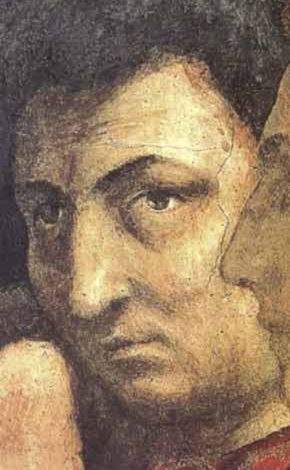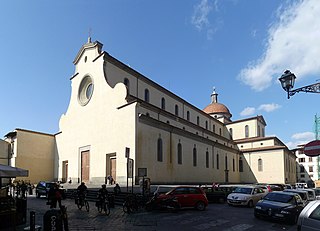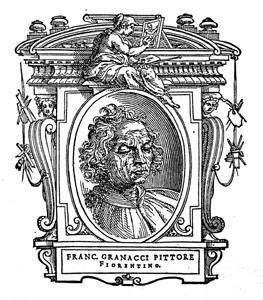
Masaccio, born Tommaso di Ser Giovanni di Simone, was a Florentine artist who is regarded as the first great Italian painter of the Quattrocento period of the Italian Renaissance. According to Vasari, Masaccio was the best painter of his generation because of his skill at imitating nature, recreating lifelike figures and movements as well as a convincing sense of three-dimensionality. He employed nudes and foreshortenings in his figures. This had seldom been done before him.

Filippino Lippi was an Italian Renaissance painter mostly working in Florence, Italy during the later years of the Early Renaissance and first few years of the High Renaissance. He also worked in Rome for a period from 1488, and later in the Milan area and Bologna.

Andrea del Castagno or Andrea di Bartolo di Bargilla was an Italian Renaissance painter in Florence, influenced chiefly by Masaccio and Giotto di Bondone. His works include frescoes in Sant'Apollonia in Florence and the painted equestrian monument of Niccolò da Tolentino (1456) in Florence Cathedral. He in turn influenced the Ferrarese school of Cosmè Tura, Francesco del Cossa and Ercole de' Roberti.

Santa Maria Novella is a church in Florence, Italy, situated opposite, and lending its name to, the city's main railway station. Chronologically, it is the first great basilica in Florence, and is the city's principal Dominican church.

Tommaso di Cristoforo Fini, known by his nickname Masolino da Panicale, was an Italian painter. His best known works are probably his collaborations with Masaccio: Madonna with Child and St. Anne (1424) and the frescoes in the Brancacci Chapel (1424–1428).

Filippo Lippi, also known as Lippo Lippi, was an Italian Renaissance painter of the Quattrocento and a Carmelite priest. He was an early Renaissance master of a painting workshop, who taught many painters. Sandro Botticelli and Francesco di Pesello were among his most distinguished pupils. His son, Filippino Lippi, also studied under him and assisted in some late works.

Fra Diamante was an Italian Renaissance painter.

Raffaellino del Garbo (1466–1527) was a Florentine painter of the early Renaissance.

The Brancacci Chapel is a chapel in the Church of Santa Maria del Carmine in Florence, central Italy. It is sometimes called the "Sistine Chapel of the early Renaissance" for its painting cycle, among the most famous and influential of the period. Construction of the chapel was commissioned by Felice Brancacci and begun in 1422. The paintings were executed over the years 1425 to 1427. Public access is currently gained via the neighbouring convent, designed by Brunelleschi. The church and the chapel are treated as separate places to visit and as such have different opening times and it is quite difficult to see the rest of the church from the chapel.

The Basilica di Santo Spirito is a church in Florence, Italy. Usually referred to simply as Santo Spirito, it is located in the Oltrarno quarter, facing the square with the same name. The interior of the building – internal length 97 m (318 ft) – is one of the preeminent examples of Renaissance architecture.

Sant'Ambrogio is a Roman Catholic church in Florence, region of Tuscany, Italy. It is named in honour of St Ambrose.

Francesco Granacci was an Italian Renaissance painter active primarily in his native Florence. Though little-known today, he was regarded in his time and is featured in Giorgio Vasari's Lives of the Artists.

Florentine painting or the Florentine school refers to artists in, from, or influenced by the naturalistic style developed in Florence in the 14th century, largely through the efforts of Giotto di Bondone, and in the 15th century the leading school of Western painting. Some of the best known painters of the earlier Florentine School are Fra Angelico, Botticelli, Filippo Lippi, the Ghirlandaio family, Masolino, and Masaccio.

This article about the development of themes in Italian Renaissance painting is an extension to the article Italian Renaissance painting, for which it provides additional pictures with commentary. The works encompassed are from Giotto in the early 14th century to Michelangelo's Last Judgement of the 1530s.

The Tribute Money is a fresco by the Italian Early Renaissance painter Masaccio, located in the Brancacci Chapel of the basilica of Santa Maria del Carmine, Florence. Painted in the 1420s, it is widely considered among Masaccio's best work, and a vital part of the development of Renaissance art.
Felice di Michele Brancacci was a Florentine silk merchant, best known for commissioning the decoration of the Brancacci Chapel. The nephew and heir of Piero di Piuvichese Brancacci, he was involved in Mediterranean silk trade, and also acted as a diplomat.

The Funeral of Saint Jerome is a painting by the Italian Renaissance painter Filippo Lippi of Saint Jerome's funeral. It is housed in the Museo dell'Opera del Duomo next to the Cathedral of Prato, central Italy.

Andrea di Giusto, rarely also known as Andrea Manzini or Andrea di Giusto Manzini was a Florentine painter of the late Gothic to early Renaissance style in Florence and its surrounding countryside. Andrea was heavily influenced by masters Lorenzo Monaco, Bicci di Lorenzo, Masaccio, and Fra Angelico, and tended to mix and match the motifs and techniques of these artists in his own work. Andrea was an eclectic painter and is considered a minor master of Florentine early Renaissance art. Andrea trained under Bicci di Lorenzo as a Garzone. He painted his most significant works, three altarpieces, in the Florentine contado, or countryside; these altarpieces were created for Sant’Andrea a Ripalta in Figline, Santa Margarita in Cortona, and the Badia degli Olivetani di San Bartolomeo alle Sacce near Prato. Aside from his major altarpieces, Andrea painted several Frescoes over the course of his career. He, along with other minor masters, are also known to have provided several different types of art, including triptychs and frescoes, for Romanesque pievi, or rural churches with baptistries. Moreover, he was well known for several types of smaller craft objects, such as small tabernacles. He is said to have worked between 1420 and 1424 under Bicci di Lorenzo on paintings for Santa Maria Nuova. He is said to have worked with Masaccio in painting the Life of San Giuliano for the Polyptych of Pisa, including the painting of the Madonna and Child, in 1426. He also appears to have collaborated in 1445 with Paolo Uccello in the Capella dell'Assunta in the Prato Cathedral. In 1428, he is listed as a member of the Arte dei Medici e Speziali guild in Florence as "Andrea di Giusto di Giovanni Bugli". His son, Giusto d'Andrea, was also a painter and worked with Neri di Bicci and Benozzo Gozzoli. Andrea died in Florence in 1450.

The Florentine Renaissance in art is the new approach to art and culture in Florence during the period from approximately the beginning of the 15th century to the end of the 16th. This new figurative language was linked to a new way of thinking about humankind and the world around it, based on the local culture and humanism already highlighted in the 14th century by Petrarch and Coluccio Salutati, among others. Filippo Brunelleschi, Donatello and Masaccio's innovations in the figurative arts at the very beginning of the 15th century were not immediately accepted by the community, and for some twenty years remained misunderstood and in the minority compared to International Gothic.






















